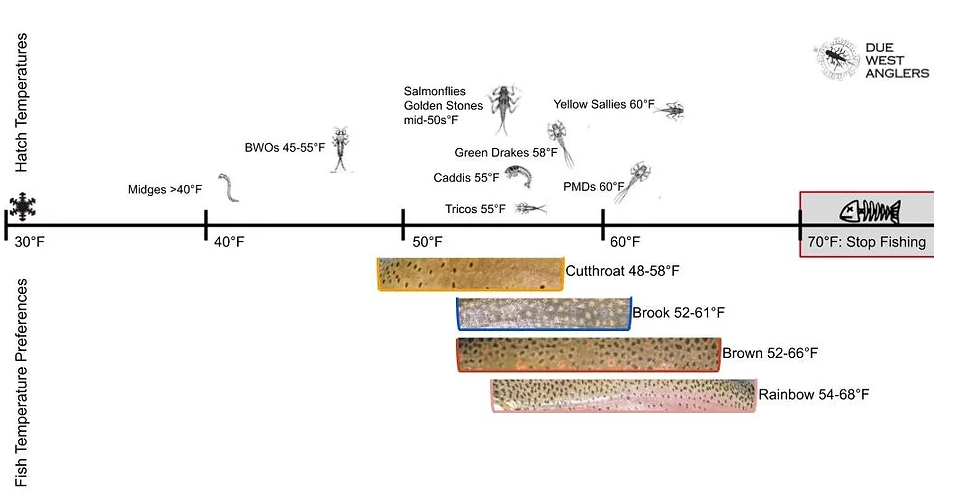An Angler's Guide to Stream Temperatures
Did you know that your thermometer can be useful to uncover all kinds of fly fishing clues? Bug hatches, fish preferences, fish behavior...

Revised May 2024
Do you carry a thermometer when you fish? If you do, you’re most likely using it to check rising water temperatures during the later summer. But did you know that your thermometer can be useful to uncover all kinds of fishing clues? Like how temperature certain temperatures cause different fish behaviors, and when you can expect certain bugs to hatch. Think of this as your temperature cheat sheet.
As I already stated, the most important reason to carry a thermometer is to watch out for rising water temperatures during late summer. Here are the temperatures you’re watching out for:
- 68°F, the point where trout start to experience extra stress, when anglers should start to limit their fishing to cooler periods of the day
- 70°F, the temperature where you shouldn’t be fishing, target early morning or late evening
Each species also has their preferred temperature ranges:
- Rainbow Trout: Preference 60°F, Optimum Range 54-68F°
- Brown Trout: Preference 60°F, Optimum Range 52-66F°
- Brook Trout: Preference 59°F, Optimum Range 52-61F°
- Cutthroat Trout: Preference 57°F, Optimum Range 48-58F°
Water temperature directly influences how much dissolved oxygen is in the water, so when the temperature is right, trout can breathe easier. Additionally, when living in their optimal temperature range, a trout’s metabolic rate is maximized. For anglers, that corresponds to the point when fish are lining up at the buffet!

Remember that trout are cold-blooded, and their activity is dependent upon their environment. So when temperatures are lower, and less optimal, fish will be congregated in places where they can conserve energy, like deep pools. In early spring, fish will still be congregated in their winter lies when river temperatures are around 40°F. As it warms up and the temperatures begin to rise over the course of a sunny day, fish may spread into the riffles, heads of pools, or pocket water. By the time temperatures reach 50-55°F, fish will be dispersed over the river in varying habitats and holdings.
When stream temperatures reach optimal range, trout will disperse and feed in a variety of habitats (riffles, pools, runs). Not just feeding to survive, they will be feeding to grow, as their bodies are operating at peak efficiency. This is important information when every angler is holed up in the usual spots, because the fish aren't in their winter holes anymore...
When temperatures climb too much, feeding again can tail off. A study conducted on Montana’s Madison River found that as temperatures rose above 19°C (66°F), angler's catch rates began to drop. As temperatures increase, a trout's demand for oxygen also increases, but the water is oxygen depleted. Not only are all stream creatures breathing more and more (depleting oxygen), but the molecular structure of water traps less dissolved oxygen at higher temperatures. This could explain the drop in angler catch rates. The researchers also found that downstream sections were more impacted, as temperatures tend to increase faster the further you venture downstream. Great things to keep in mind while angling during summer months!

What about the bugs?
Now we know more about how fish respond to different temperatures, but how can we use temperature to clue us into what bugs might be active?
You might already know the yearly hatch progression for your area, but out West the hatches generally progress like this: start in the early winter with midges, then BWOs follow, caddis, salmon flies, golden stones, green drakes, PMDs, and yellow sallies, tricos, fall BWOs, and finally winter midges to round out the year. As you’ve probably guessed by know, there are certain temperature cues that these insects follow to create such a progression.

- Midges can hatch anytime when water temperatures are above freezing, but local guides expect the first noticeable hatch to occur above 40°F.
- BWOs like a range of 45-55°F. They prefer overcast skies to emerge.
- Caddis follow around 55°F. Spring brings the Mother’s Day hatch, but many caddis species hatch throughout the season.
- Salmonflies and Golden Stoneflies can be a tough one to predict. Look for this hatch with temperatures in the mid-50s, and the hatches coincide with high water. So, you need both ingredients for the magic to happen. Goldens will immediately follow the salmonfies and don't hang around long.
- Green Drakes are another tricky hatch. I've been told 58°F is the number to watch for, but I’ve seen them hatch during the night time, day time, afternoon, and mid-morning depending on the conditions. So keep some flies on hand, because when it happens, you’ll want to be fishing!
- PMDs appear around 60°F and hatch into late summer. They are often associated with Yellow Sallies which appear around the same time.
- Tricos can happen anytime above 55°F and might pop-off earlier than listed in this sequence. But they can also emerge late into the summer. Males usually hatch the night before followed by the famed spinner fall the next morning. Later in the year the males might appear in the morning, with the spinner fall in the evening.
- Fall BWOs hatch when temps drop to the mid-50s, coinciding with the shortening days. Fall BWOs will be smaller than their more robust spring counterparts. October Caddis also hatch later in the season around this time.
- Midges become prominent again by the time the temps drop further into the 40s. Fall midges will be smaller than their spring counterparts.
One Final Caution
There are many studies published about the influence of temperature on aquatic systems. It's sometime referred to as the "master variable". Often, these studies come to different conclusions about who prefers what temperature. Therefore, use this guide as a general reference, but be ready to refine these guidelines. Local variations, like unique strains or environmental conditions, could influence temperature cues in your region.
Sources:
1. Temperature Classifications of Fish. The Scientific Fisherman. 2019.
2. Interview with Devin Olsen on The Orvis Fly Fishing Podcast. Tom Rosenbauer. 2018.
3. Thermometers, Not Just for Skipping Class. Cutthroat Anglers. 2012.
4. Relations among Stream Temperature, Angling Success for Rainbow and Brown Trout, and Angler Satisfaction. McMichael & Kaya, 2011.
5. Comparative Thermal Requirements of Westslope Cutthroat Trout and Rainbow Trout: Implications for Species Interactions and Development of Thermal Protection Standards. Bear et al. 2011.
6. Brook Trout Species and Conservation Assessment. Adams et al. 2008.
7. Habitat Suitability Index: Rainbow Trout. Raleigh et al. 1984.


